Words Sarah Langton-Lockton Photographs Lisa Valder
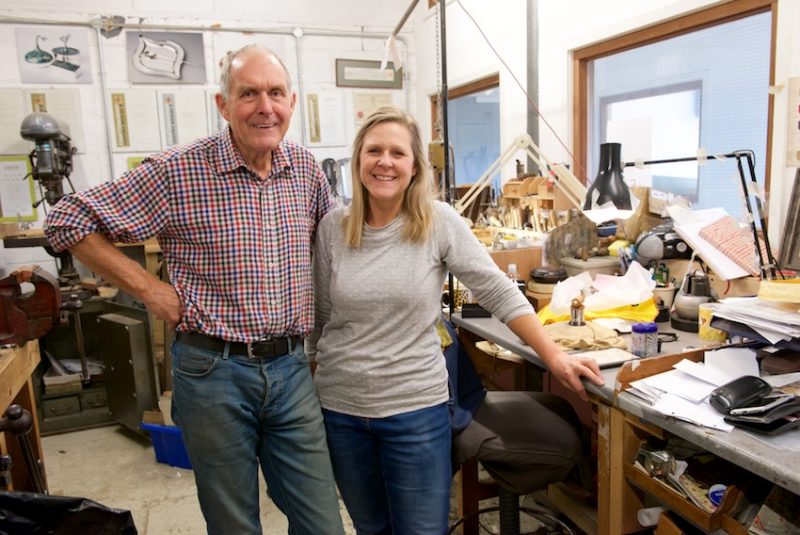
David Bedford and his apprentice, daughter Sarah Hobbs
The letter was neatly typed on letterhead bearing the name J J Bergin, 11 Lancashire Court, New Bond Street, W1. Describing the company as ‘Heraldic, General and Machine Engravers, Saw Piercer’, the letter, dated June 1965, and signed by J N Bergin (whom he came to know as Norrie), was addressed to David Bedford, then aged 17. It was an offer of employment as an apprentice, working a 44-hour week at an hourly rate of 4s 6d (£12 per week).
Thus began the career of an outstanding practitioner of hand engraving, whose commissions have included a gold letter opener presented to Her Majesty The Queen for her Silver Jubilee in 1977 and the wording inside the wedding rings of TRH The Prince of Wales and The Duchess of Cornwall, copied from their own handwriting, as well as countless sporting trophies and cufflinks, and in times past, long-service medals and watches. On a visit to his workshop in 2011, the Chairman of The Heritage Craft Association recorded his impressions as follows: ‘One man whose craft work exhibits excellence is hand engraver David Bedford. His skills were a joy to see. Hand engraving requires a good eye, a steady hand and a mastery of technique.’
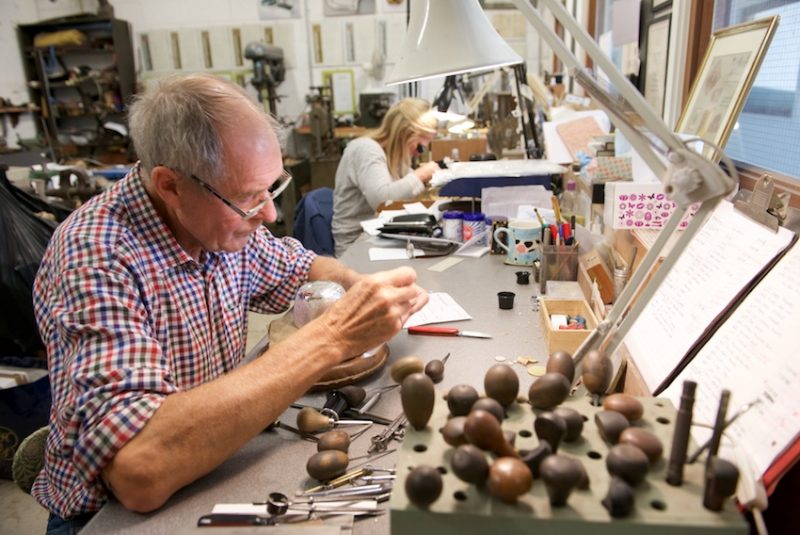
‘A good eye, a steady hand and a mastery of technique’
David’s artistic talents were evident from early childhood. At school, he excelled at art, woodwork, craft and technical drawing. He left school at 14 with an A in art, and embarked on a three-year general course on art and industrial design at Canterbury Art College. ‘We did a bit of everything, graphics, life drawing and silversmithing, of which engraving was a sideline.’ Students made a few copper pots and were told they could do some engraving. ‘I just took to it,’ recalls David. ‘I thought this is something I can settle down and do.’
At the end of his course, he was told to write off to London, as that was where he would learn the basic skills. David diligently wrote to all the London engravers he could identify, and was invited for interview by Mr Bergin, hence the letter quoted above. Joining the firm in November 1965, David was put to work alongside Leslie Hunt, who became his tutor for the next four or five years. Writing in a precious small book that records the history of the company from 1894 to 2013, David says of his tutor: ‘A small rotund man with a cheerful nature, we got on famously. He said right from the start: “Forget what you’ve been taught so far. I will now show you how it should be done.”’
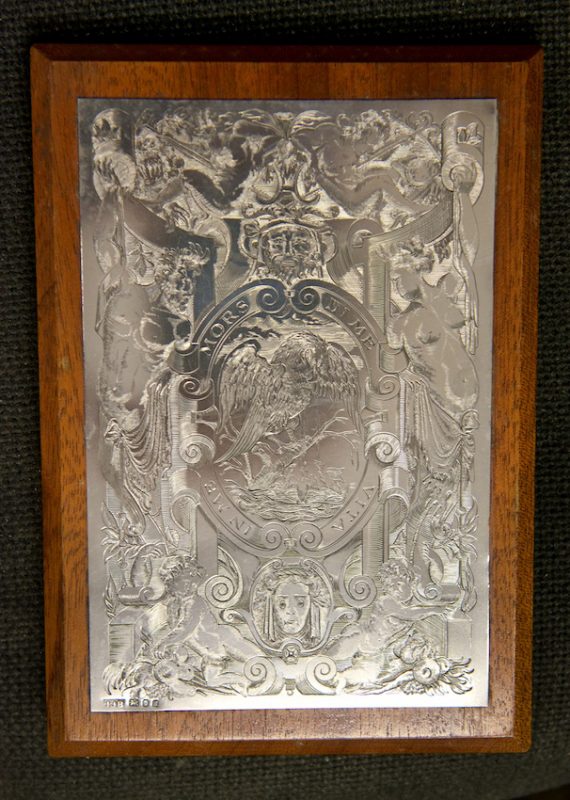
A heraldic piece taken from an old book
‘I picked it up pretty quickly,’ says David. ‘Within 10 years I was their top engraver. Many years later, the boss said: “I think I should have paid you more.”’ When David joined J J Bergin, the company employed six engravers. Over the years it got smaller and smaller, and David says that most people now work on their own. Although it was all happening in Carnaby Street, just a short walk away, the premises at Lancashire Court were somewhat Dickensian – ‘up dusty old stairs, dim lighting and no running hot water.’ The location, however, in the West End of London, near Bond Street, attracted prestigious customers, many of them, such as Garrard, the Crown Jewellers, Asprey, Georg Jensen and Cartier, in the retail trade.
In the 1970s the lease at Lancashire Court ended. ‘We had to move several times,’ recalls David. ‘Leases would run out and the owners would increase the rents and convert workshops into offices, flats and restaurants. This was happening all over central London.’ J J Bergin moved to Store Street and almost 19 years later to Clerkenwell Workshops. Ten years later, this building too was being refurbished and going upmarket. The next move was to a small former printing works not far away.
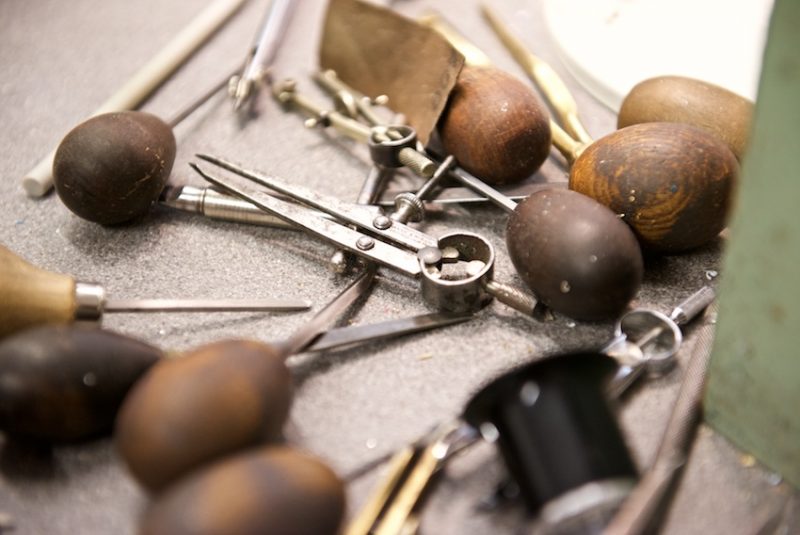
Traditional hand engraving tools, including gravers
In 1977, Norrie Bergin retired and David Bedford and his colleague Bill Trickey took over the company. When Bill retired, David says: ‘I was prepared to chuck it all in too.’ Mercifully, his friend the silversmith Ray Walton (see Faversham Life profile) had just moved into his spacious basement workshop at Creek Creative in Abbey Street in Faversham, and said: ‘When you leave London I’ve got plenty of room here.’ David’s London lease ran out at the end of May 2012, and after 46 years of commuting, he moved into Creek Creative.
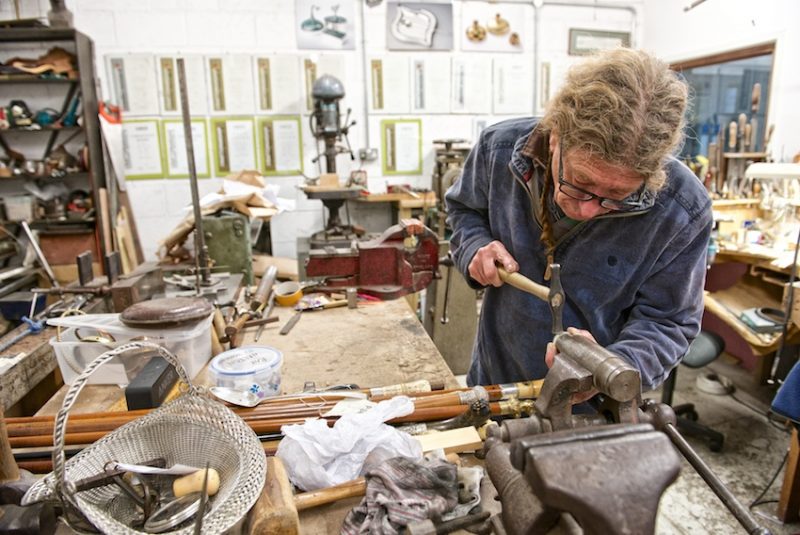
Silversmith Ray Walton in the shared workshop
The workshop is packed with the tools of the silversmithing and engravers’ trades, many of them unchanged over the last 100 years or so. There is venerable machinery, made or modified for particular tasks, but most in evidence are the hand tools, in David’s case the scribers for marking out and the gravers for free cutting. There are clamps and jigs for holding items and a state-of-the-art ball vice. On his workbench is a planished silver whisky tumbler, the light catching the gentle indentations left by the planishing hammer. It will have the family crest on one side and the date in Roman numerals on the other. The piece is for a London customer – 80 to 90 per cent is London work, says David, and 90 per cent of that is for the trade.
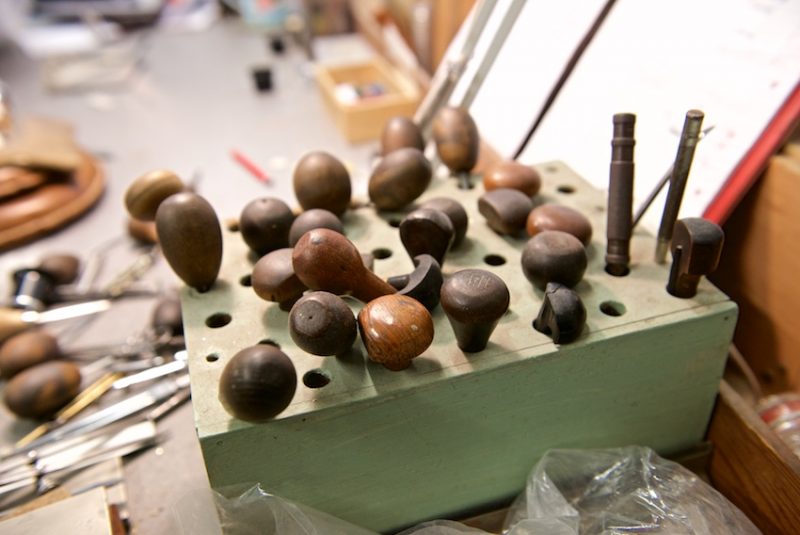
Gravers ready for use
Inscriptions on rings, bracelets, cufflinks, bangles and signet rings, together with family crests and coats of arms, form the bulk of the work. ‘More than half the job is marking on,’ says David. Plasticine is rubbed lightly over the surface that will receive the inscription, then a light dusting of powder to take the shine off. The lettering can then be sketched on with a pencil, scribed with a steel point before being hand cut with a graver (also known as a burin), which is like a miniature chisel with a bulbous wooden handle and a metal shaft with a 2mm square tip. The gravers come in a basic shape and the shaft can be heated and bent into a curve, for example for working on a bowl.
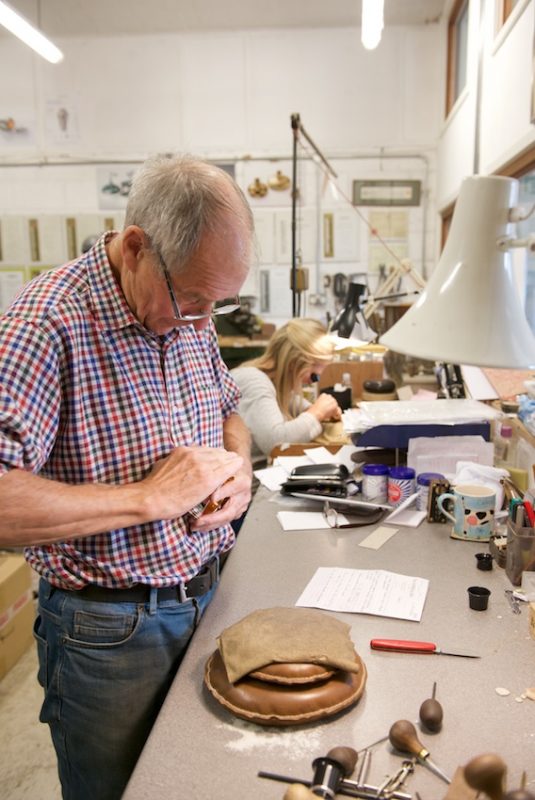
Work is done on a sandbag with a soft covering of chamois leather
J J Bergin has grown since it moved to Faversham to include Sarah Hobbs, David’s daughter, now in her second year as a full-time apprentice to her father. This is possible thanks to bursaries from the Queen Elizabeth Scholarship Trust, whose tagline is ‘supporting excellence in British craftsmanship’. In 2014 QEST established an apprenticeship scheme to support the wages and training costs of people seeking careers in traditional crafts. These range widely and currently include farriery, gun and spectacle making, textile conservation, cordwaining, clog making and affinage (the maturing of cheese).
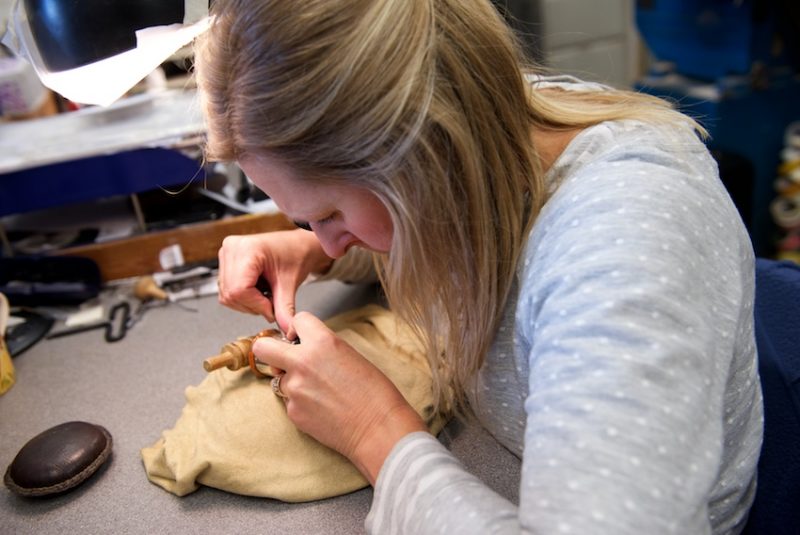
Sarah focuses intently on her work
Sarah, who lives in Doddington, studied for a National Diploma in Art and Design at Canterbury Art College, then ran a shop with her sister, painting traditional pub signs and painting furniture freehand. Until David moved J J Bergin to Faversham, an apprenticeship with the company was not an option. ‘It was not on the cards to get her to London,’ says David, ‘because of the travel costs and the time. As soon as we came here, there was the opportunity to have a go.’
Sarah likes the variety of the work and has started to enjoy lettering. It’s usually copperplate script or Roman, but they can do all sorts of languages. ‘If it’s clear enough, I can copy it,’ says David.’ A job Sarah worked on with her father involved trips to the Silver Vaults in Chancery Lane (‘I could hear the underground rumbling alongside us’) to touch up and recut 24 silver tea services (worn out by polishing) belonging to the Thai Royal Family.

George and the Dragon
An exhibition piece of St George and the Dragon, from the J J Bergin original sample book, is her entry for the engraving section of this year’s Goldsmiths’ Craft and Design Annual Awards. ‘It took 80 hours,’ says Sarah gravely. It is a very fine piece, which bears the motto Labore et Diligentia, meaning ‘with labour and diligence’. Add ‘artistry’ and you have a rather good motto for this consummate craft business.
J J Bergin Ltd
Unit 4 Creek Creative
1 Abbey Street
Faversham
Kent ME13 7BE
Tel 01795 538674